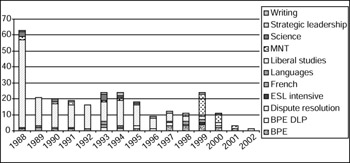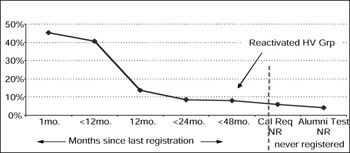Bringing Them Back
|
The School of Continuing Studies at the University of Toronto is a self-sustaining academic division of the university that welcomes about 15,000 adult learners each year and offers courses in three program areas: business and professional studies, arts and humanities, and English as a second language.
Recently, the school had to replace its existing registration system. This system had been in place for more than 12 years, and, although it could generate business reports and track registrations, the actual customer data were locked within its tables. The new system was Oracle-based. The school’s director saw this as an opportunity for the school to take advantage of its customer data and employed Terri O’Connor as the school’s first database marketer.
Making Sense of the Data
Terri put the customer records from both the old and the new registration systems into a separate database. In order to make sense of the data, the records from the two systems were merged to create a unique customer record that provided a profile of the customer. During this process, Terri used RFM to help summarize the customer data.
The frequency indicator provided the school with its first database surprise. The administrators had always known that they had a significant number of long-term customers, but they were very surprised to learn that some customers had purchased more than 50 courses in the previous 12 years. Terri termed these the high-value (HV) customers and started to track their retention rates and the types of courses they were purchasing. The breakdown is shown in Figure 8-2.

Figure 8-2: Currently Registered HV Customers by Start Date and Program Area
Recency and LTV
The school used several methods to distribute its course calendars. One of the most effective methods was to mail them directly to customers who had registered within the previous 2 years. When Terri started to assemble the first house list using the new database, she assigned a source code to each customer for tracking purposes. The addition of the source code meant that the list and the individual customer cells could be tracked separately. She reviewed the customer records and was able to locate and include a group of customers who had a high lifetime value (LTV) but had not purchased courses for 3 or 4 years. Normally this group of customers would be excluded, since it is too costly to mail calendars to customers who haven’t purchased in 3 or 4 years. But by targeting only the customers in this group who had a high LTV, Terri was able to keep the mailing costs manageable while she attempted to reactivate their business. The result was that 8 percent of those who were targeted purchased courses, and their purchasing habits were as high the second time around as they had been originally. The reactivated HV group bought an average of three courses each per year compared to the school’s overall average of 1.45.
The impact of recency on course purchases is obvious in Figure 8-3. By assigning RFM indicators to the customer base, Terri was able to find new revenue from “lost” customers and to gain some valuable insights into the school’s best customers.

Figure 8-3: Sales Rates for the House List Calendar Mailing
Marketing to customer segments by direct-mail promotions is relatively easy. Going beyond that by appointing segment managers and managing segments on a daily basis is much more complicated and seldom profitable. Let’s take a look at one enterprise that succeeded.
|
EAN: 2147483647
Pages: 226